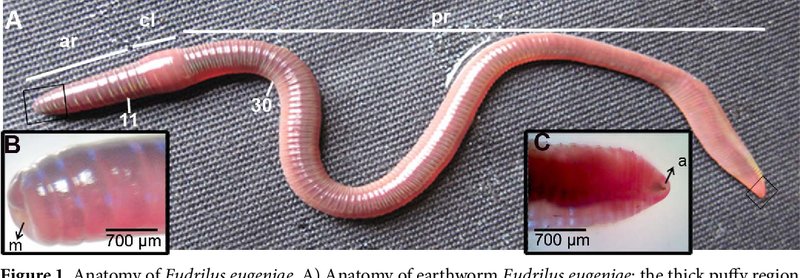
Imagine *Eisenia hortensis* as tiny vacuum cleaners for the earth, munching through organic matter and transforming it into nutrients that our plants can thrive on. Their feeding process isn’t just about getting their next meal; it plays a crucial role in maintaining healthy ecosystems. So, let’s dig deeper into how these remarkable creatures dine, step by step.
Understanding the Anatomy of Eisenia Hortensis
Before we dive into their feeding process, it’s helpful to understand the basic anatomy of *Eisenia hortensis*. These worms may seem simple, but they have some neat features that assist in feeding.
Their bodies are divided into segments called annuli. Each segment contains muscles and other structures crucial for movement and feeding. At the front, they have a specialized mouth that looks remarkably like a little suction cup. This mouth, combined with their ability to extend their bodies, allows them to burrow into the soil and consume organic matter efficiently.
In addition to their mouth, *Eisenia hortensis* possesses a pharynx, which further aids in the ingestion of food. This muscular structure helps pull in decomposing organic material and soil, ensuring they get a balanced diet. By understanding their anatomy, it becomes clear how perfectly designed they are for their role in nature.
The Feeding Process: Step-by-Step
Let’s walk through the feeding process of *Eisenia hortensis* step by step. It’s a bit like a well-orchestrated dance!
Step 1: Ingestion
The first step in the feeding mechanism is the actual ingestion of food. *Eisenia hortensis* starts by using its mouth to take in bits of organic material, which can include leaves, decaying plant matter, and even microorganisms. As they burrow through the soil, they’re constantly sampling their surroundings.
You might be wondering how they know what to eat. Well, their keen sense of taste helps them distinguish between what’s nutritious and what’s not. Imagine them as tiny chefs, carefully selecting the freshest ingredients from the soil.
Step 2: Processing the Food
After ingestion, the food travels down into their body. This is where the processing begins, which takes place in a specialized section called the gizzard. The gizzard is like a grinding mill; it crushes the organic material into smaller pieces, making it easier for the worm to absorb nutrients.
Here’s the thing: *Eisenia hortensis* doesn’t have teeth, but they don’t need them! The combination of muscular contractions and the grit they consume helps break everything down. It’s similar to how we chew our food — the more you break it down, the easier it is for your body to absorb those nutrients.
Step 3: Nutrient Absorption
Once the food is sufficiently processed, it moves into the intestines. This section is vital for nutrient absorption. The intestines are lined with special cells that help absorb nutrients into the worm’s bloodstream.
At this stage, *Eisenia hortensis* is like a sponge, soaking up essential nutrients like nitrogen and phosphorus that plants rely on to grow. This process not only keeps the worm healthy but also enriches the soil, benefiting everything from grass to garden vegetables.
Step 4: Excretion
The last step in the feeding cycle is excretion, where the indigestible parts of the food get expelled from the worm’s body. What comes out are nutrient-rich castings, often referred to as “worm poop.”
These castings are incredible for the soil. They improve soil structure, increase moisture retention, and provide essential nutrients for plants. So, when you see healthy, thriving plants, thank *Eisenia hortensis* for their hard work!
Why the Feeding Mechanism Matters
You might be thinking, “So what? Why should I care about how *Eisenia hortensis* eats?” Here’s the thing: understanding their feeding mechanism helps us appreciate their role in our ecosystems.
These worms play a critical part in breaking down organic matter, recycling nutrients, and aerating the soil. Their feeding habits contribute to healthy plants, which in turn support other life forms — from insects to larger animals.
In gardens, having a thriving population of *Eisenia hortensis* can mean the difference between a flourishing vegetable patch and a struggling one. Their castings are often sought after as natural fertilizers, showcasing just how valuable their feeding process is.
Common Misunderstandings About Eisenia Hortensis
Many people might assume that earthworms simply eat dirt, but that’s a common misconception. While they do consume soil, it’s mostly as a means to access organic matter within it.
Additionally, some may think that all earthworms have the same feeding capabilities, but *Eisenia hortensis* is specialized for composting and thrives in nutrient-rich environments. This distinction is crucial when considering how different types of worms can benefit our gardens and landscapes.
The feeding mechanism of *Eisenia hortensis* is not just a mundane biological process; it’s a beautiful dance that showcases nature’s complexity. From ingestion to excretion, these little worms transform our environment in ways we often take for granted.
Understanding how they work helps us appreciate their role in the ecosystem and inspires us to cultivate healthier gardens. So next time you see an earthworm, remember the behind-the-scenes work they’re doing to keep our planet thriving!
